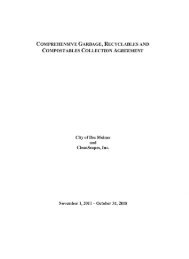CITY OF DES MOINES SHORELINE MASTER PROGRAM
CITY OF DES MOINES SHORELINE MASTER PROGRAM
CITY OF DES MOINES SHORELINE MASTER PROGRAM
You also want an ePaper? Increase the reach of your titles
YUMPU automatically turns print PDFs into web optimized ePapers that Google loves.
Des Moines Shoreline Inventory and Characterization<br />
• Nonpoint pollutant runoff from impervious surfaces and residential lawns near the<br />
shoreline.<br />
Eelgrass Meadows<br />
The importance of eelgrass has been described in various sources, including the Reconnaissance<br />
Assessment of the State of the Nearshore Environment (KCDNR, 2001). Eelgrass beds are found<br />
in intertidal areas and provide feeding and rearing habitat for a large number of marine<br />
organisms. Eelgrass beds have been documented in Puget Sound in the City’s shoreline<br />
jurisdiction, in Segment A, E, F, and G (WDNR, 2001 and KCDNR, 2001). Densities are<br />
considered patchy and not continuous (Figure 14). Shoreline activities that may impact eelgrass<br />
(KCDNR, 2001) include:<br />
• Clam harvesting;<br />
• Propeller scour and wash;<br />
• Physical disturbances from shoreline armoring;<br />
• Shading from overwater structures; and<br />
• Physical disturbances from dredging and filling.<br />
Kelp Forests<br />
The function of kelp has been described in Reconnaissance Assessment of the State of the<br />
Nearshore Environment (KCDNR, 2001). Kelp provides habitat for many fish species, including<br />
rockfish and salmonids, potential spawning substrate for herring, and buffers to shoreline from<br />
waves and currents, among other functions. Kelp distribution is largely dependent upon the type<br />
of substrate. Kelp prefers a rocky substratum for attachment. In areas where there is a<br />
coarsening of substrate in the low intertidal and shallow subtidal zones, there is a more likely<br />
occurrence of kelp. A change in kelp distribution may indicate the coarsening of shallow<br />
subtidal sediments (such as that caused by erosion related to a seawall) or an increase in nutrient<br />
loading (such as from sewage effluent). Kelp forests are not currently mapped within the City of<br />
Des Moines shoreline jurisdiction. KCDNR (2001) indicates that it is likely that kelp<br />
distribution has changed over time based on maps produced by the USDA in 1911-1912 and for<br />
the Coastal Zone Atlas during the mid-1970's (Thom and Hallum, 1990). Kelp was reported as<br />
occurring along a greater length of shoreline within all reaches of WRIA 9, which would include<br />
the City of Des Moines shoreline (KCDNR, 2001). KCDNR also noted data gaps in general<br />
knowledge of kelp and its biology, its role in nearshore ecological processes, lack of historical or<br />
recent studies, and lack of distribution data.<br />
Shoreline activities that may impact kelp densities (KCDNR, 2001) include:<br />
• Physical disturbances from shoreline armoring, marina construction, and harvesting;<br />
• Shading from overwater structures;<br />
• Beach nourishment; and<br />
• Nutrient loading.<br />
Page 34 March 2005



